Game Link:
I highly recommend playing before reading the iteration history because there will be spoilers.
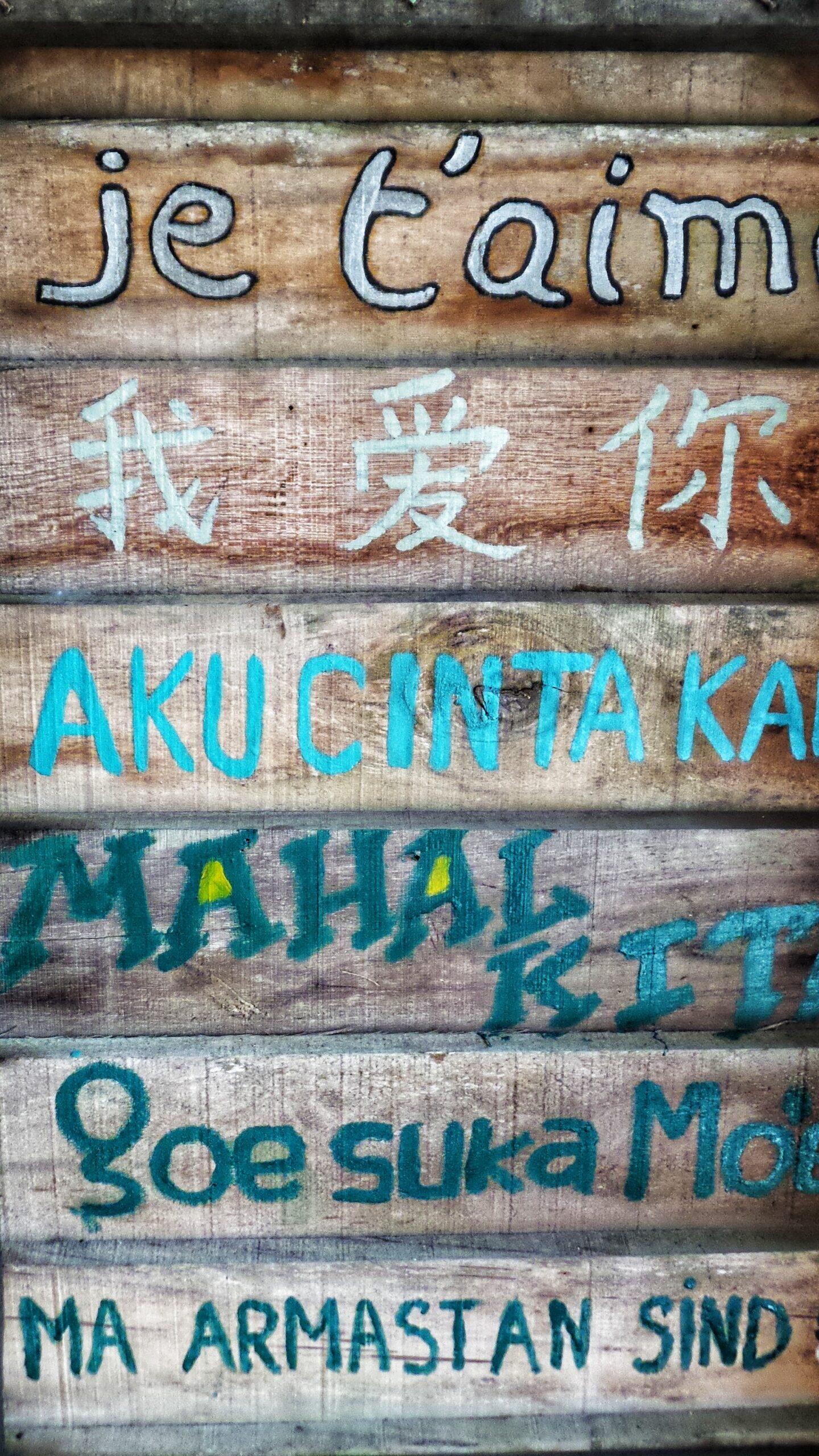
[Lost Voices, Lost Souls]
Overview of the game
Learning Goal
This game aims to prompt players to consider how language impacts cultural identity.
The learning goal was assessed with the following three questions, asked before and after the player played the game.
- What do you think a language does?
- What is language diversity’s effect on the world?
- How a language shapes a person?
Premise
The story takes place in a faraway galaxy of planets habituated by different aliens, all with different languages, cultures, and values. There is one most advanced planet of them all, SaphirA, on where every alien in this galaxy wants to live. With their advanced technology, the Saphirian government developed a language software implant for immigrants which will make them native speakers of Saphirian in no time. It is mandatory for every immigrant to install the software in their brain. The protagonist is a new alien immigrant who just arrived in SaphirA, finding out that the discrimination against foreign aliens bad was rampant in the Saphirian society and suffered from discrimination. What’s more, although aliens on SaphirA were supposedly from various planets with different cultures and characteristics, you weren’t able to see any special characteristics in aliens around you. Every alien was so similar. The protagonist found out that the language software gradually overwrote every user’s native language and culture and instilled Saphirian culture, and decided to join a rebel force against the government to destroy the language software and retrieve the freedom to keep immigrants’ own languages.
Origin
Where does this game come from? Mostly, it is from my own identity. I was born and raised in Guangzhou, a city in the most Southern part of China. My native language was Cantonese, a dialect of Chinese that is very different from Mandarin. I learned Mandarin when I was a kid and grew up speaking both.
Since I came to the U.S. six years ago, I have always been fascinated by the difference between the American and Chinese cultures and how I think and speak differently when I use Chinese and English, these two languages from very different cultures. I was also intrigued by how second-generation immigrants associate the language of their parents with positive, negative, or mixed feelings depending on their opinions of their heritage, causing them to choose to or not to learn their parents’ language.
Out of my experience as a foreigner living in a place where people speak a different language and my interest in language’s effect on cultural identity, I came up with this story. I wanted to prompt the player to think deeper about the relationship between their language and their culture, and how that had shaped their thinking.
Iteration History
The first version of the story that I wanted to tell was centered around discrimination and oppression against minority groups. I didn’t have the full game planned out yet, but I was thinking of the protagonist as an alien immigrating to a new planet and getting treated unfairly. After getting lots of discrimination, the protagonist starts a rebellion against the planet’s leader.
Playtest 1
In this playtest, I tested out the beginning of the story with scenarios written on paper and observed with the following questions in mind:
- Do players engage in the story?
- Is the story interesting to the player? Will it make them care about what I want to tell them?
A very simple prototype on paper was tested, with a few choices that led to different stories. After they finished the prototype, I also told them verbally about what may happen afterward and asked for their opinions on the story. I shared with them that the first try/fail loop I intended to write was that the protagonist witnessed that his childhood friend, Jax, was bullied in the company because of his heritage. The protagonist would have to choose between standing up for Jax or remaining silent. If the player chooses to stand up, they will get fired and have to find a new job, which is very hard.
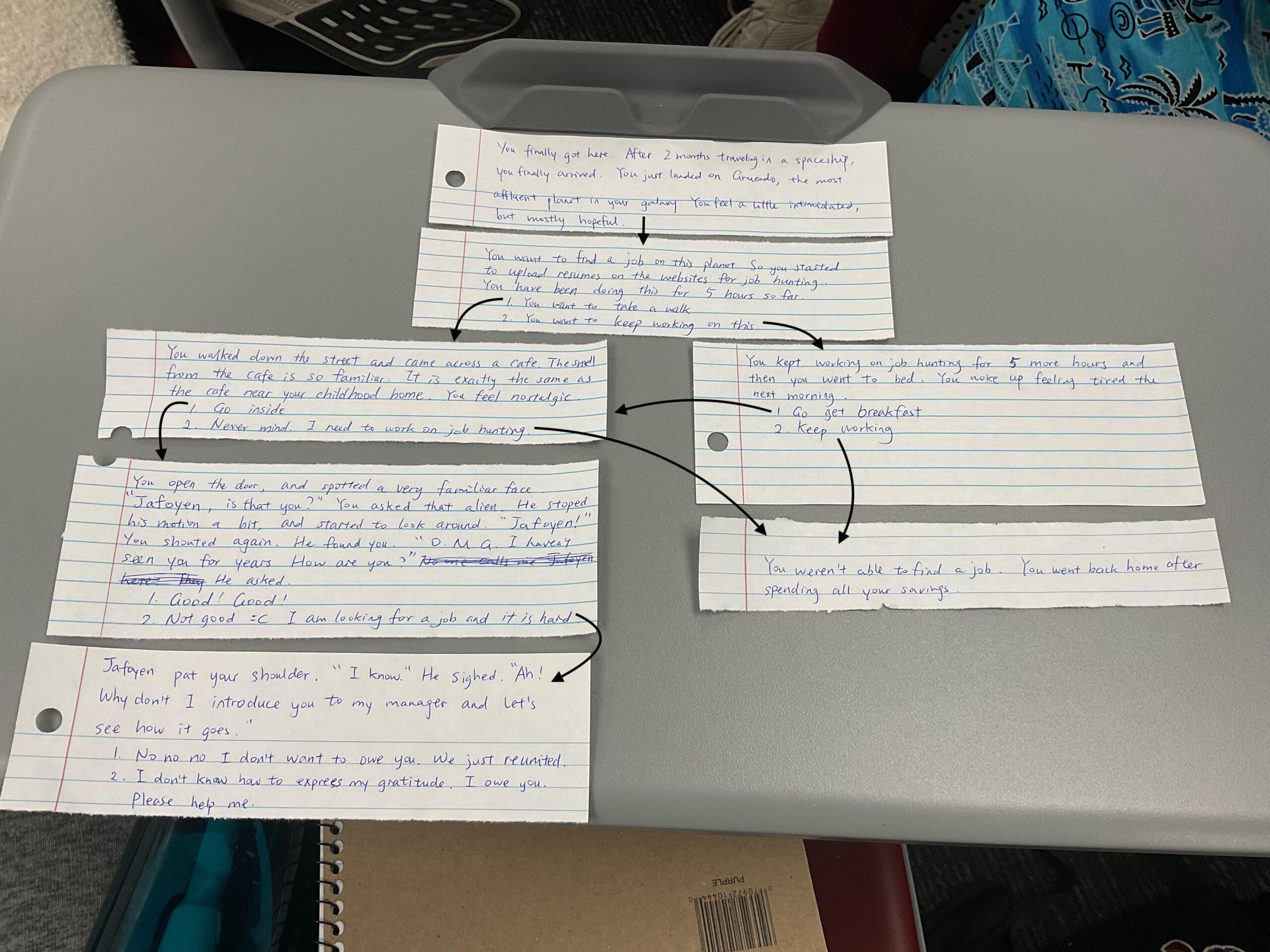
Playtesters: Ecy and Alahji, who are in their early twenties and are both computer science students at Stanford.

From my observation, the playtesters were engaged in the game. The playtesters reported that they could visualize the scenes in their head while playing the game and they liked the scenes depicted in the stories. For example, the job hunting scene elicited an anxious and urgent feeling in the playtesters (probably due to shared experience), and the familiar cafe scene elicited a nostalgic emotional response in the playtesters.
The main feedbacks I got were that (1) the game was a bit too “vanilla” and needed more drastic conflict and tension, (2) and it would be great if there could be more sci-fi elements specific to the extraterrestrial setting.
What I kept/changed: I decided to keep the scenarios and elicited strong emotional responses from the playtesters, and changed the story of my game to involve more conflict and tension.
I honed in on my interest in language preservation between the first and the second playtest, so I make a shift in the focus of my game from just discrimination to language and discrimination. At this point, I was writing the story as outlined in the premise.
Playtest 2
I wrote drafts of the story on Word and then move them to Twine.
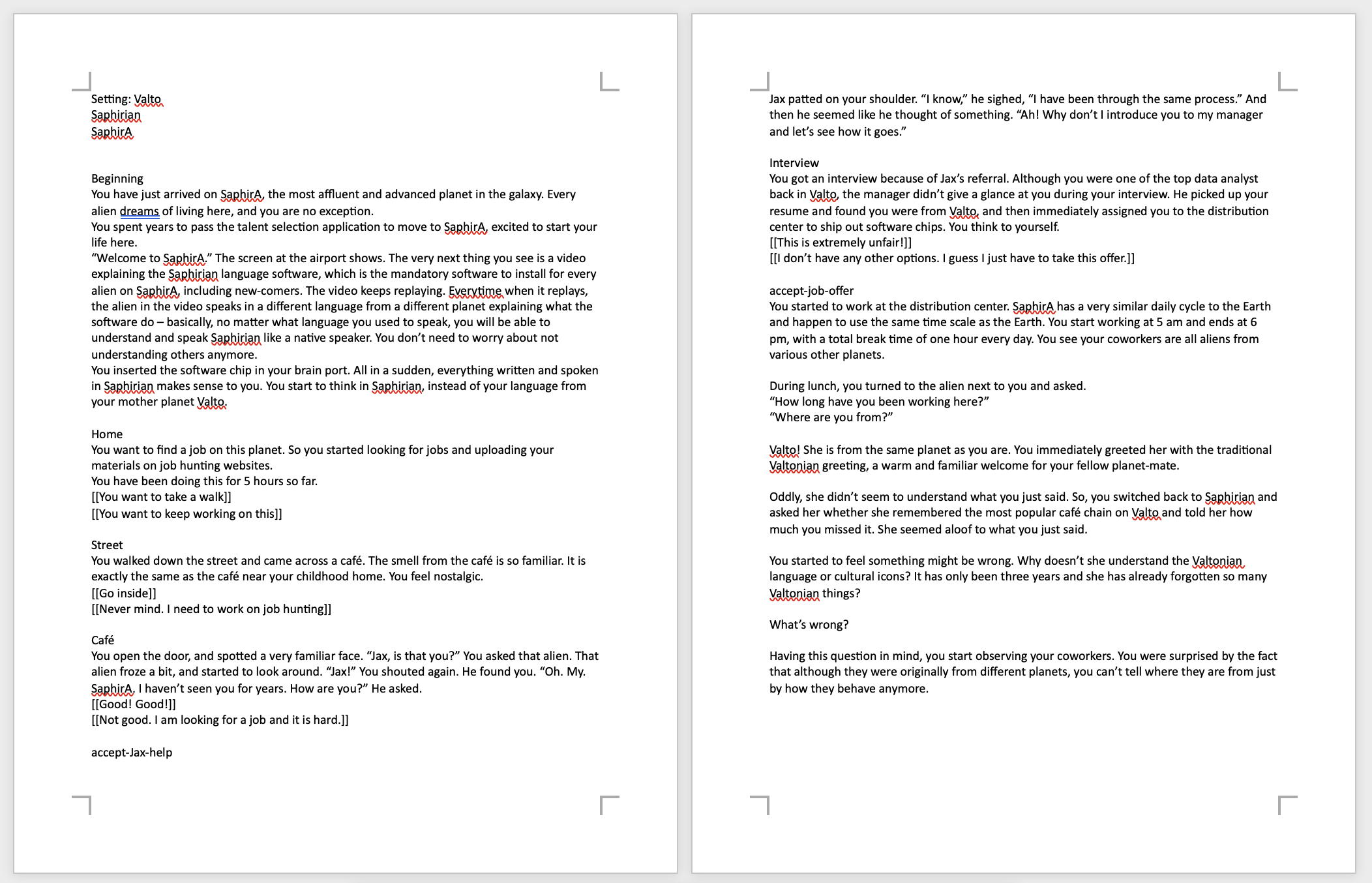
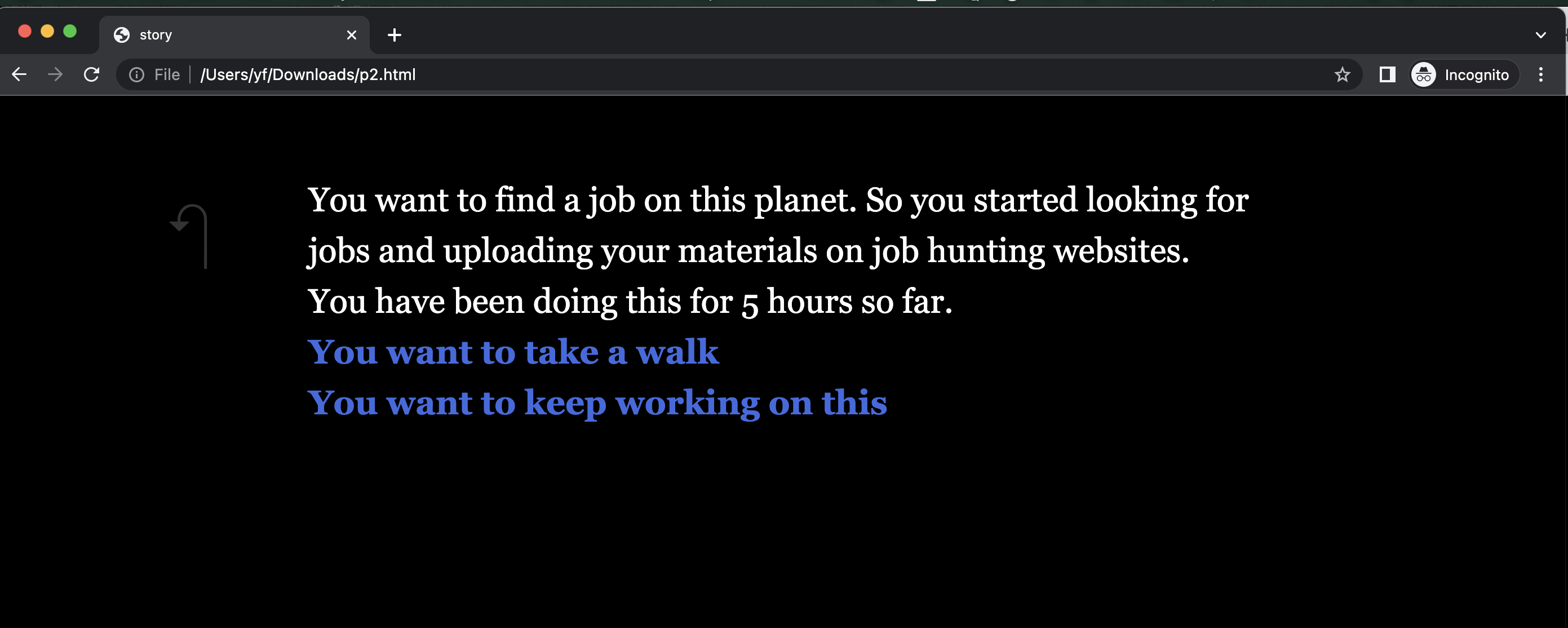
I conducted these playtest with these three questions in mind:
- Can the story achieve the learning goal, conveying the message I want to convey to the player?
- Is Twine a good platform to use?
- Does the player feel like they are making meaningful choices?
Playtester: Shimea
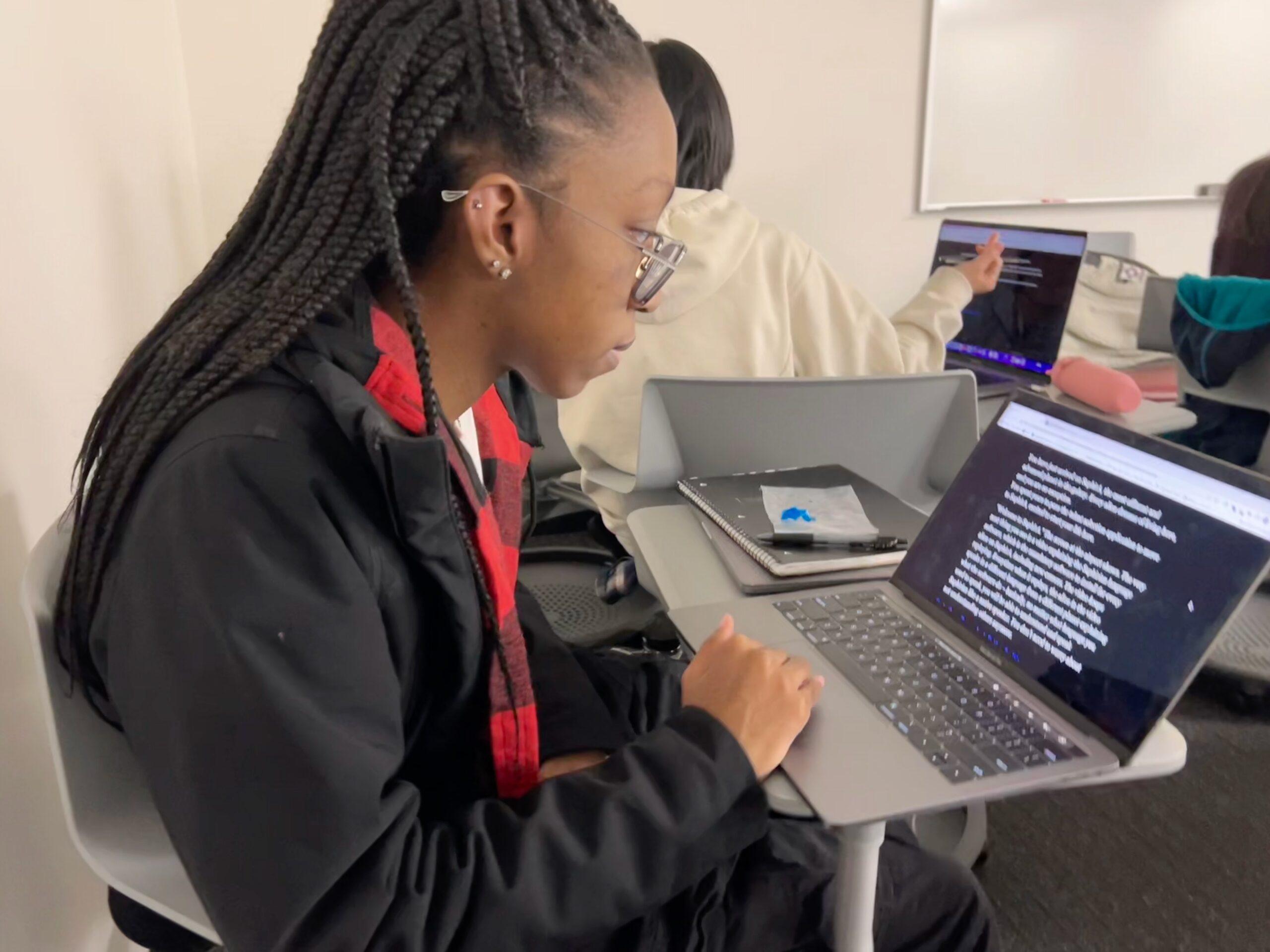
When asked about the assessment questions listed in the Learning Goal section before the game, Shimea reported that language diversity does more bad than good to the world because it builds barriers between people who speak different languages.
The most interesting observation was how her attitude toward the language software changed as she played the game. When she started the game and found out about the language software, she was very excited about it and wanted to get it. However, when she found out the language software would wipe out her native language, she disliked it very much and said “This is so bad. I don’t want my culture to be wiped out.” That was the change of thought that I was aiming for in this game.
When asked about the same assessment questions after playing, Shimea reported that this game prompted her to see a deeper link between one’s language and cultural identity. So the learning goal was met.
The main feedback I got was that she liked the premise and the side characters, and the try/fail loops needed more work.
The main change I had after this playtest was to add more choices for the player. Since the learning goal was met, I focused on adding more details to the story. I added a lot more endings to the game (there was only one ending but there are six possible endings to the game now.) I also added more stories to the side characters to add on to the story.
Playtest 3
In this playtest, I tested out the complete game on Twine.
Playtester: Shana

What the playtester wanted to be changed:
- The endings other than the main ending are a bit extreme. They can hint at a better ending.
- The sequence of choices didn’t let the player go back and forth between them. More nuances were expected.
What the playtester liked about:
The characters all had their characteristics. For example, the protagonist is from Valtonian culture, which is a collectivist culture in which individuals are less important than the group. So the protagonist chose to sacrifice himself at the end of the game to free all other immigrants. The Lindy/Tiana parallel is an interesting contrast between protecting and giving up one’s cultural heritage.
I didn’t have enough time to implement all the changes. I added hints for a main ending to the early sub-endings, which made them much less abrupt. I also added more stories for Lindy to illustrate her love for her family. I also cut some choices and endings that didn’t add much to the core story.
I did:
Overall, in this game, I spent a lot of time crafting the story and deciding what message i want to tell the player with my game. I found it really rewarding to think of what to keep and what to cut in a game. I shared the story with many people and asked for their feedback. I compared different mediums of platforms for interactive fiction and decided Twine was the best choice for the branching story that I was writing.
I learned:
I learned that choices form how players view the game and what they learn from the game. When they think their choices are meaningful, they put more thought into them, and those thinking processes make the player engage in the game more and learn better.
Next time I’d do it this way:
If I get to do it again, I will spend less time thinking about the story and put more effort into crafting the learning arc of the player. Most of the choices in my game have immediate short time effects. I want to write a longer story for the players to see the long-term effects of their choices. Some of the choices in my game lead to extreme outcomes, so I would love to add more nuances to them and make the transitions softer.
I would also love to add audio and visual effects to strengthen the extraterrestrial vibe and make the experience more immersive.



Functional description is definitely super important to the value of this game. As we’re entering a new world not based on Earth, the designer has to do a very good job to set the players up for success to give them a quick but strong description of the world they’re visualizing. I think Charlette does an amazing job at that as I was able to get sucked into the realm and determine what the issue was pretty early on–the assimilation of language and moreover, culture.
This game taught me the importance of language and the downfalls of assimilation. I think the “rebels” had every right to undermine the government as this narrative fits right in with what the US is like. As I was playing the game, I felt this sense of justice that I must do something or else I’ll be brainwashed and homogenized. Language and cultural preservation are very important and I draw from my own experiences when making decisions as a Chinese American student.
Twine was a great choice for this game as there were different endings that the players could end up with. I ended up dying but the world was successfully saved–so it was self-sacrifice. I also clicked back around and saw that I could die if I betray the rebels and die at the beginning if I didn’t go out for a stretch and talk to Jax honestly–or even go back to my home planet. I was wondering if there was an ending I lived and the world was saved. I think the choices were super enticing and at times I was wondering if I made a wrong choice that would leave me with a bad ending. Since there were three endings, definitely my choices matter as they all impacted how I would live my life. I really love the story. I was on the edge of my seat the whole time exploring this universe and the characters were so well fleshed out and the distinction between the alien nations. The premise was super cool and the different endings and plot twists and progression were awesome as well.
If you were to make this into P4, maybe just keep building on the world and characters and maybe even incorporate more endings. That could make choices you make even more costly and up the stakes of your game–although your game is at pretty high stakes at the moment.
“Lost Voices, Lost Souls” is a decision-based interactive fiction game that explores the importance of language and cultural preservation in a new world. As I played the game, I saw the value of cultural diversity and the negative impact of assimilation. The game designer, Charlotte Feng, did an excellent job of setting up the world and the issues that the protagonist faces. The use of Twine as the platform for the game allowed for multiple endings and choices that impacted the outcome of the game. The values reflected in the game include cultural preservation, diversity, and justice. The game designer emphasizes the importance of preserving one’s language and culture, as the protagonist and other immigrants lose their native language and culture over time. The rebels in the game fight for justice and to preserve cultural diversity, which shows the importance of valuing different perspectives and experiences. In terms of getting me to care about the given topic or cause, the game did an excellent job. As a player, I felt invested in the story and the fate of the protagonist and the community. The game’s use of the medium fit the story perfectly, as the decision-based gameplay allowed for the exploration of different outcomes based on the player’s choices. The choices in the game were interesting and consequential, especially as they impacted the outcome of the story. I appreciated the multiple endings and the impact that my choices had on the story. The game’s premise was super cool, and the plot twists and progression were well executed. One thing I appreciated about the game was how well the characters were fleshed out and the distinction between the alien nations. The game designer did an excellent job of creating a fully realized world with relatable characters. If I were to suggest an area for improvement, it would be to potentially incorporate even more endings and choices, especially early on in the game as I noticed that there were many instances where I did not have options to choose and was forced to take the direction that was designed by Charlotte. This would make the choices even more consequential and up the stakes of the game. Overall, Lost Voices, Lost Souls was a really enjoyable game.